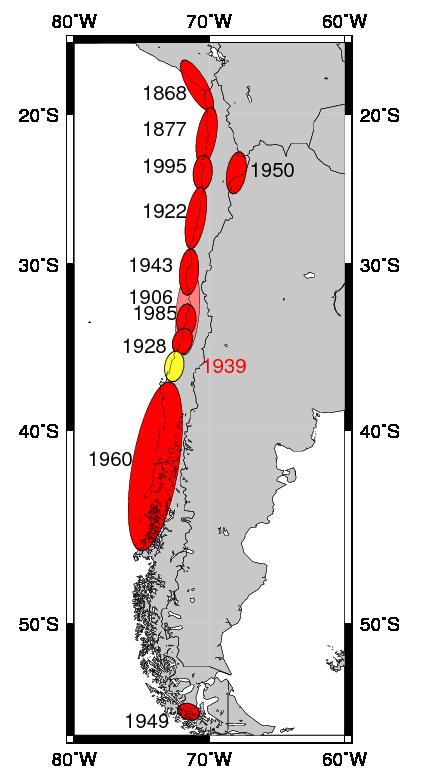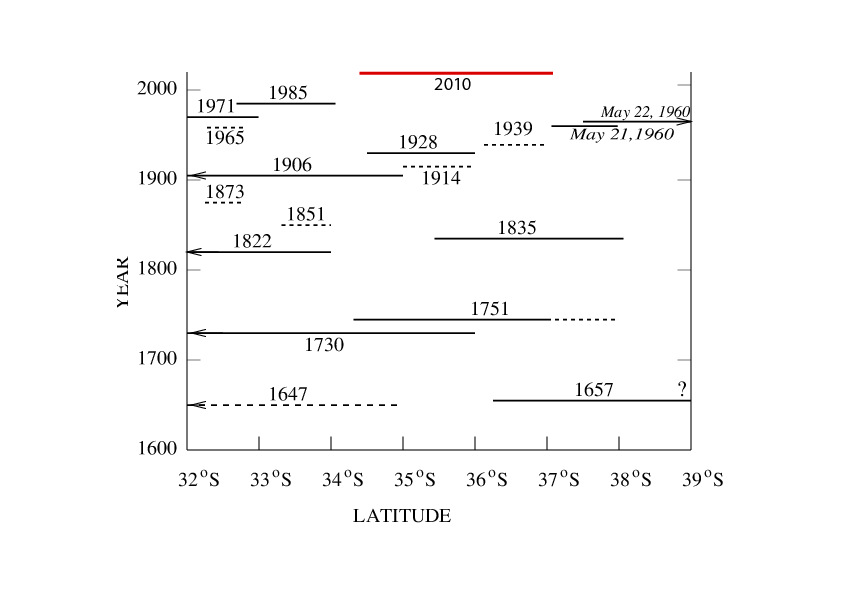


The region between 35 and 37°S along the Chilean subduction zone was known to be a long-standing seismic gap. The last time this region had a large subduction earthquake was on 20 February 1835 at 11:40 AM. Darwin was in Valdivia, very close to the hypocenter in the Beagle and wrote about the earthquake in his book about his travel (Darwin, 1843).
An incomplete history of the identification of the gap.
Until the late 80s, the Constitución-Concepción region was thought to have ruptured in the earthquake of 28 January 1939, the most deadly earthquake of the 20th century in Chile. In the early analyses of the central Chile gaps it was considered that this area had had a recent earthquake
(see figure on the right ->)
Around 1990 several abstracts from Chilean seismologists (Barrientos, 1990; Campos and Kausel, 1990) suggested that this event was not a “typical” subduction zone earthquake but an intermediate depth event that occurred inside the Nazca plate below central Chile.
This was confirmed by Madariaga (1998) who found that Gutenberg and Richter (page 7, 1940) had determined the hypocentral depth of this event at 70 km. Beck et al (1998) studied all records of Large Chilean earthquakes and determined that the 1939 event had a typical intermediate depth “slab-pull” earthquake (an event due to tension along the downgoing Nazca plate).
Events of this kind are common in Chile, e.g. the 1950 Antofagasta earthquake, 1965 La Ligua earthquake, 2005 Pica earthquake, etc. (see Malgrange et al (1983) for an early study)
The seismicity of central Chile is very well known, at least for the major events, since the arrival of Spaniards in Chile. Thanks to the work of many historians and his own research, Montessus de Ballore (1912-1916) wrote a monumental treatise on Andean earthquakes. This work was completed by many authors including Greve (1964), Lomnitz (1970, 2004), etc. Further data was available from tsunami histories of the Pacific. From these works we derived the following earthquake history.

Although the 2010 earthquake broke the expected area (the region of the 1835 event) it broke a much larger area that is, as far as we know at the time of writing, very similar to that of the 25 May 1751 earthquake around 1 AM. That event produced a similar tsunami that lead to the relocation of the city of Concepción to a new more protected site an the Bio-bio river. The new city founded on 8 December 1754 became present day Concepción.
In 1996 was carried out the first seismological study of the area and a campaign mode network of GPS sites was measured for the first time. Seismic data reported by Madariaga et al (1998) and Campos et al (2002) showed that although the region of the gap was very active at depth, it showed practically no activity on the plate interface, suggesting that this was locked.
The geodetic network was measured several times at irregular intervals. In a first study by Ruegg et al (2002) it was confirmed that the area was locked and in much more detailed studies by Ruegg et al (2009) , Métois et al (2010), Moreno et al (1969) etc it appeared clearly that the area was fully locked and that the depth of locking was greater in the gap than elsewhere along the Chilean coast.
References
Darwin, C., Journal of researches into the natural history. (John Murray, London, 1845) (PDF).
Montessus de Ballore, F., Historia Sismica de los Andes Merdionales, Cervantes, Santiago (1911-1916).
Lomnitz, C., Geofis. Panamericana, 1, 151 (1971).
Lomnitz, C., Seismol.Res. Lett., 75, 368 (2004)
Kelleher, J., J. Geophys. Res. 77, 2087 (1972).
Nishenko, R., J. Geophys. Res. 90, 3589 (1985).
Barrientos, S. Seismol. Res. Lett., 61, 43 (1990).
Gutenberg, B. and Richter, Special Public. Geological. Soc. Amer. Special Papers, (1941).
Madariaga, R. Física de la Tierra (Madrid), 10, 221 (1998). (PDF)
Beck S. et al J. South Amer. Earth Sci. 11, 115 (1998).
Madariaga R. and the Final report to the European Community, (1998) (PDF)
Malgrange et al. Geophy. J. Roy. Astr. Soc. (1983)
Campos et al. Phys. Earth Planet. Int. 132, 177 (2002).
Klotz, J. et al, Earth. Planet. Sci. Lett., 193, 437 (2000).
Ruegg, J. C. et al Geophys. Res. Lett. 29 , doi:10.1029/2001GL013438, (2002).
Brooks, B. A. et al, Geochem. Geophys. Geosyst. , doi:10.1029/2003GC000505 (2003).
Moreno, M. et al. Geochem., Geophys. Geosys, 9, doi: 10.1029/2008GC002198 (2008).
Ruegg, J. C. et al Phys. Earth Planet. Int, 175, 78 (2009).
Vigny, Ch. Et al, Phys Earth Planet. Int. 175, 58 (2009).